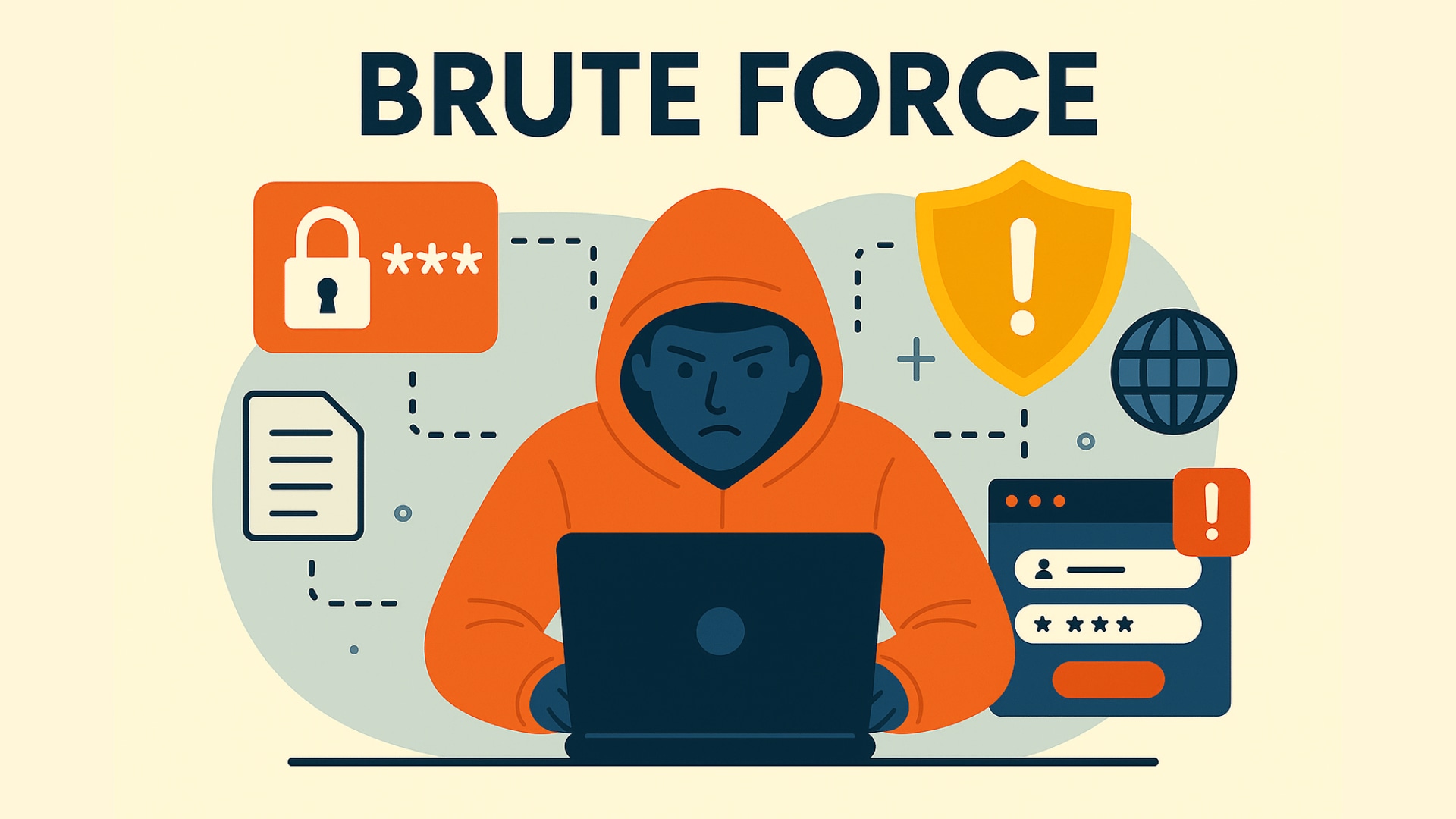
A brute force attack is one of the most basic yet effective methods hackers use to break into online accounts and systems. The attacker relies on automated tools to systematically guess passwords, login credentials, or encryption codes by trying every possible combination until they find the right one. Imagine trying to open a safe by guessing all possible combinations. This method works because it’s a numbers game — pure volume and speed — rather than a complex or advanced technique.
Brute force attacks have been around for a long time and remain effective, especially when passwords are weak or easy to guess. These attacks can target anything from user login credentials to encrypted data. Attackers use scripts or tools that perform thousands, or even millions, of password guesses every minute, making brute force attacks efficient when compared to manually attempting passwords.
However, the real threat lies not just in the time it takes to crack a password but in the damage it can cause. Once a hacker successfully gains access to a system, they can steal sensitive data, install malware, or hijack systems for further attacks. Therefore, understanding the mechanics of a brute force attack, its potential damage, and how to protect against it is critical for any business.
Table of contents
Why Do Hackers Use Brute Force Attacks?
The reason brute force attacks remain so popular among cybercriminals is their simplicity and effectiveness. When hackers successfully break into accounts or systems, the payoff can be significant. For instance, gaining access to financial data or personal information (PII) allows attackers to commit fraud or sell this information on the black market. This is one of the key motivations for conducting brute force attacks.
Beyond stealing data, attackers can use compromised accounts to distribute malware within a network. This could potentially infect more devices and systems. A successful attack on an admin-level account gives hackers access to critical infrastructure. This allows them to sabotage systems, install malicious software, or launch further attacks like phishing campaigns.
Brute force attacks also pose a reputation threat. If attackers target a public-facing website and gain access to customer accounts, they can post harmful content. The damage to the company’s reputation can be severe. Combined with the potential for financial loss, brute force attacks remain a persistent and dangerous threat.
Types of Brute Force Attacks
While the core principle of brute force attacks remains the same — relying on trial and error to guess passwords — hackers have developed different strategies to make their attacks more effective.
For example, dictionary attacks involve using a list of common words and phrases to guess passwords. Hackers rely on the likelihood that many users pick simple or common passwords. In contrast, hybrid attacks combine dictionary words with numbers or special characters, which may be based on personal information about the user. These hybrid methods increase the chances of success without trying every possible character combination.
Another approach is reverse brute force, where attackers start with a known password, often obtained from a previous breach, and try it against multiple usernames. This method takes advantage of the common habit of reusing passwords across various sites. Hackers are also known to employ credential stuffing, which involves using login credentials obtained from one site and trying them on others, relying on the tendency of users to reuse the same password across multiple platforms.
Advanced Threats: AI and ML in Brute Force Attacks
Brute force attacks, traditionally based on sheer volume, are evolving with the rise of artificial intelligence (AI) and machine learning (ML). Hackers are now using machine learning algorithms to optimize brute force methods. They do this by predicting the likelihood of certain passwords being used. Unlike simple trial-and-error methods, machine learning helps attackers identify common patterns. It also enables them to prioritize password guesses intelligently.
Using machine learning, attackers can train models to predict user behaviors. They analyze historical data such as frequently used words, numbers, and combinations. This allows brute force attacks powered by AI to adapt and become more efficient over time. The models learn which password types are most likely to succeed based on their target’s profile.
For example, by analyzing social media profiles, attackers can create password combinations. These include names, birthdates, or favorite sports teams. This dramatically increases their chances of success. As a result, even complex passwords may be cracked faster if they are predictable or based on personal data.
Given this increasing sophistication, it’s more important than ever for businesses to implement advanced security measures such as behavioral analysis, multi-factor authentication (MFA), and machine learning-powered defense systems to detect and counter these AI-driven brute force attacks before they succeed.
Preventing Brute Force Attacks
To protect against brute force attacks, a multi-layered security approach is essential. Both system administrators and end users play a key role in ensuring robust protection.
For system administrators, enforcing strong password policies is essential. Passwords should be at least 12 characters long and include a mix of letters, numbers, and special characters. Avoiding predictable patterns and common words makes passwords harder to guess.
Limiting failed login attempts is another effective defense. After a set number of unsuccessful tries, accounts should be temporarily locked or require additional verification steps. Progressive delays, where each failed attempt increases the time before retrying, slow down attackers and frustrate automated tools.
Multi-factor authentication (MFA) provides another layer of security. Even if an attacker compromises a password, MFA requires a second form of verification, such as a code sent to a phone. This makes unauthorized access significantly harder.
Salting password hashes is crucial for protecting stored passwords. By adding a random string (salt) to each password before hashing it, attackers can’t easily crack the password using precomputed tables (rainbow tables). This ensures even if attackers gain access to password data, it remains secure.
Monitoring user behavior is also vital. IP Blocking can prevent malicious access, and real-time monitoring tools help detect unusual patterns, such as multiple failed login attempts from unknown locations. Additionally, incorporating CAPTCHA challenges in login or registration forms can block bots from carrying out automated attacks.
Impact of Brute Force Attacks
Brute force attacks can cause significant damage. They often lead to data theft, which results in financial losses and legal consequences. For businesses handling sensitive customer information, the cost of a data breach goes beyond direct financial damage. It includes legal fees, fines, and the expenses involved in repairing the company’s reputation.
These attacks can also cause major downtime. If attackers lock administrators out of critical systems or disrupt services, businesses risk losing revenue and customer trust. When a website or service is unavailable, customers may seek alternatives. This leads to long-term damage to the company’s market position.
Moreover, if attackers gain access to admin accounts or high-level credentials, they can manipulate the back-end systems. This can include altering sensitive data, injecting malware, or corrupting important files. Such actions could halt operations and result in long-term damage to the business.
Legal Implications of Data Breaches
When brute force attacks succeed, the consequences are not just technical or financial; they also carry legal implications. A successful breach of sensitive data, such as customer personal information or financial details, can result in severe legal penalties under various data protection regulations like GDPR (General Data Protection Regulation) in the EU.
These regulations mandate that businesses take adequate measures to protect personal data. If a brute force attack results in a breach and it’s discovered that the company did not have sufficient security measures in place, the business could face significant fines, legal fees, and potential lawsuits. GDPR, for example, can impose fines of up to €20 million or 4% of annual global turnover, whichever is higher.
In addition to monetary penalties, businesses found guilty of negligence may suffer reputational damage. Trust is a key asset in business, and any sign that a company is unable to protect customer data can lead to a loss of credibility, ultimately affecting customer retention and business relationships.
To mitigate these risks, businesses must prioritize robust security practices, including regular security audits, password protection, encryption, and multi-layered authentication. Proactive security measures not only protect against brute force attacks but also demonstrate to regulators and customers that the business takes data protection seriously.
Conclusion
Brute force attacks continue to be a major threat in the digital landscape, but they can be mitigated with the right security measures. By enforcing strong password policies, utilizing multi-factor authentication, limiting failed login attempts, and monitoring activity, businesses can significantly reduce the risk of a successful brute force attack. Adding CAPTCHA challenges also helps slow down bot-driven attacks.
For those seeking a user-friendly, privacy-compliant CAPTCHA solution, captcha.eu offers an effective way to protect your website from automated brute force attempts and online abuse. By combining multiple defense strategies, businesses can safeguard their systems from this persistent cybersecurity threat.
FAQ – Frequently Asked Questions
What is a brute force attack?
A brute force attack is a method used by hackers to crack passwords or encryption codes by systematically trying every possible combination until they find the correct one. This attack relies on automation and computing power to speed up the guessing process.
How do brute force attacks work?
Brute force attacks use automated software to test numerous password combinations at a very fast rate. The attacker typically starts with simple combinations and increases the complexity gradually. As the attacker progresses, they attempt all possible password combinations until the correct one is found.
What is the difference between brute force and dictionary attacks?
A brute force attack involves trying every possible password combination, while a dictionary attack uses a precompiled list of common passwords or words from a dictionary. Dictionary attacks are generally faster as they focus on more likely password combinations.
What are the signs of a brute force attack?
Signs of a brute force attack include a high number of failed login attempts, unusual IP addresses attempting access, slow website performance, and alerts about system login failures. Monitoring login attempts can help detect these attacks early.
How can I prevent brute force attacks on my website?
To prevent brute force attacks, implement strong password policies, enable multi-factor authentication (MFA), limit failed login attempts, and use CAPTCHA to distinguish between human users and bots. Regular monitoring and IP blocking can further enhance protection.
100 free requests
You have the opportunity to test and try our product with 100 free requests.
If you have any questions
Contact us
Our support team is available to assist you.




